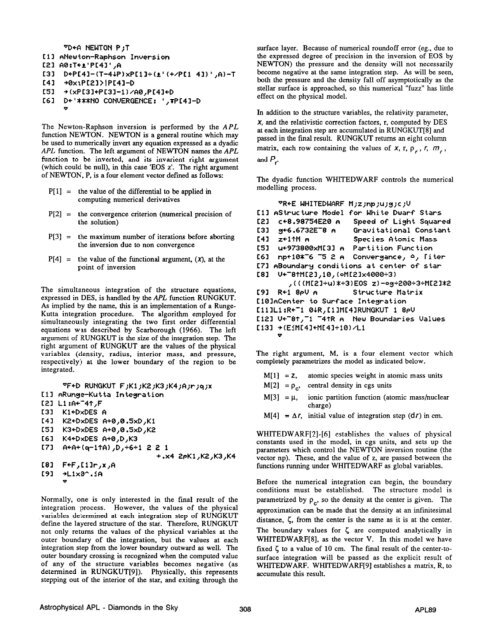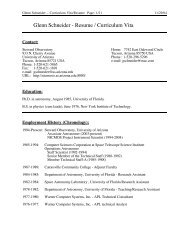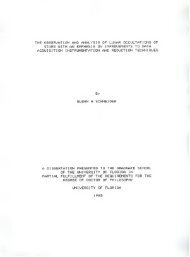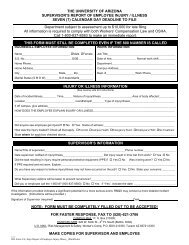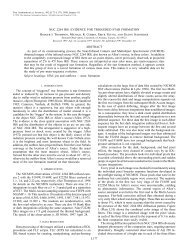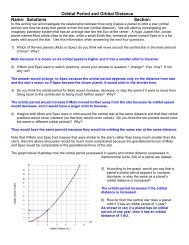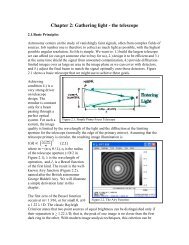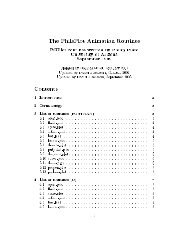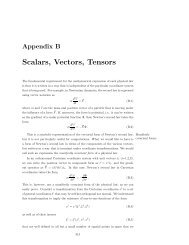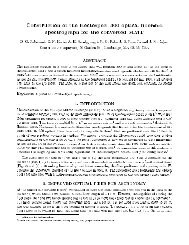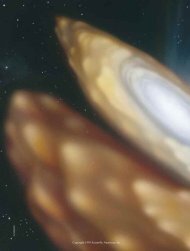ASTROPHYSICAL APL - DIAMONDS IN THE SKY
ASTROPHYSICAL APL - DIAMONDS IN THE SKY
ASTROPHYSICAL APL - DIAMONDS IN THE SKY
You also want an ePaper? Increase the reach of your titles
YUMPU automatically turns print PDFs into web optimized ePapers that Google loves.
vD+A NEWTON P;TCl3 nNewton-Raphson InversionC21 A0:T+&‘PC41’ ,AC33 D~PC~I-(T-~~P)XPC~I+(+‘(+/P~~ 4l)‘,Al-TC41 +BxtPC23>IPC41-DC51 + (xPC33+PE31-ll~A0,PC4l+DC61 D+‘*:ttNO0CONVERGENCE: ‘,TPC41-DThe Newton-Raphson inversion is performed by the <strong>APL</strong>function NEWTON. NEWTON is a general routine which maybe used to munerically invert any equation expressed as a dyadic<strong>APL</strong> function. The left argument of NEWTON names the <strong>APL</strong>function to be inverted, and its invarient right argument(which could. be null), in this case ‘EOS z’. The right argumentof NEWTON, P, is a four element vector defined as follows:P[l] = the value of the differential to be applied incomputing numerical derivativesP[2] =the convergence criterion (numerical precision ofthe solution)P[3] = the maximum number of iterations before abortingt’he inversion due to non convergenceP[4] = the value of the functional argument, (x), at thepoint of inversionThe simultaneous integration of the structure equations,expressed in DES, is handled by the <strong>APL</strong> function RUNGKUT.As implied by the name, this is an implementation of a Runge-Kutta integration procedure. The algorithm employed forsimultaneously integrating the two first order differentialequations was described by Scarborough (1966). The leftargument of IRUNGKUT is the size of the integration step. Theright argument of RUNGKUT are the values of the physicalvariables (density, radius, interior mass, and pressure,respectively) at the lower boundary of the region to beintegrated.OF+D RUNGKUT F;Kl;K2;K3;K4;A;r;q;xCl1 RRunge-Kutta IntegrationC21 Ll :A+‘-4?,Ft31 Kl+DxDES AC41 K2cDxDES A+0,0.5xD,KlC51 K3+DxDES A+0,0.5xD,K2C61 K4+DxDES A+B,D,KBC71 A+A+(q-ltA),D,+6+1 2 2 1+.x4 2pKl,K2,K3,K4C81 F+F,Cllr,x,Ac91 +LlxB^.JAvNormally, one is only interested in the final result of theintegration process. However, the values of the physicalvariables determined at each integration step of RUNGKUTdefine the l?yered structure of the star. Therefore, RUNGKUTnot only returns the values of the physical variables at theouter boundary of the integration, but the values at eachintegration step from the lower boundary outward as well. Theouter boundary crossing is recognized when the computed valueof any of the structure variables becomes negative (asdetermined in RUNGKUT[9]). Physically, this representsstepping out of the interior of the star, and exiting through thesurface layer. Because of numerical roundoff error (eg., due tothe expressed degree of precision in the inversion of EOS byNEWTON) the pressure and the density will not necessarilybecome negative at the same integration step. As will be seen,both the pressure and the density fall off asymptotically as thestellar surface is approached, so this numerical “fuzz” has littleeffect on the physical model.In addition to the structure variables, the relativity parameter,X, and the relativistic correction factors, r, computed by DESat each integration step are accumulated in RUNGKUT[8] andpassed in the final result. RUNGKUT returns an eight columnmatrix, each row containing the values of X, r, p, , r, mr ,and P,.The dyadic function WHITEDWARF controls the numericalmodelling process.-R+E WHITEDWARF M;z;np;u;g;c;UCl1 &tructure Model for White Dwarf StarsC21 cc8.98754E20 ~1 Speed of Light SquaredC31 g+6.6732E-8 FI Gravitational ConstantC41 z+l?M fi Species Atomic Masst51 u+973800xMt31 ~1 Partition FunctionC61 np+lBb-6 -5 2 FI Conuergance, 0, riterC71 RBoundary conditions at center of starC81 U+-8?MC21,10,(oMC21~4000+3~((CMC21%)*+3)EOS z)-og+200+3+MC2lt2C93 R+; 8p’J FI Strut ture MatrixElBl&enter to Surface IntegrationCllILl:R+-1 0~R,tllMC41RUNGKUT 1 8&JCl21 U+‘8t,-1 -4tR FI New Boundaries ValuesCl31 +(E’MC4l+MC41+10)~Ll0The right argument, M, is a four element vector whichcompletely parametrizes the model as indicated below.M[l] = z,M121 = pc.atomic species weight in atomic mass unitscentral density in cgs unitsMI31 = PL, ionic partition function (atomic mass/nuclearcharge)M[4] = Ar, initial value of integration step (dr) in cm.WHITEDWARF[2]-[6] establishes the values of physicalconstants used in the model, in cgs units, and sets up theparameters which control the NEWTON inversion routine (thevector np). These, and the value of z, are passed between thefunctions running under WHlTEDWARF as global variables.Before the numerical integration can begin, the boundaryconditions must be established. The structure model isparametrized by pc, so the density at the center is given. Theapproximation can be made that the density at an infinitesimaldistance, 5, from the center is the same as it is at the center.The boundary values for r are computed analytically inWHlTEDWARF[8], as the vector V. In this model we havefixed 5 to a value of 10 cm. The final result of the center-tosurfaceintegration will be passed as the explicit resuh ofWHlTEDWARF. WHlTEDWARF[9] establishes a matrix, R, toaccumulate this result.Astrophysical <strong>APL</strong> - Diamonds in the Sky 308 <strong>APL</strong>89


